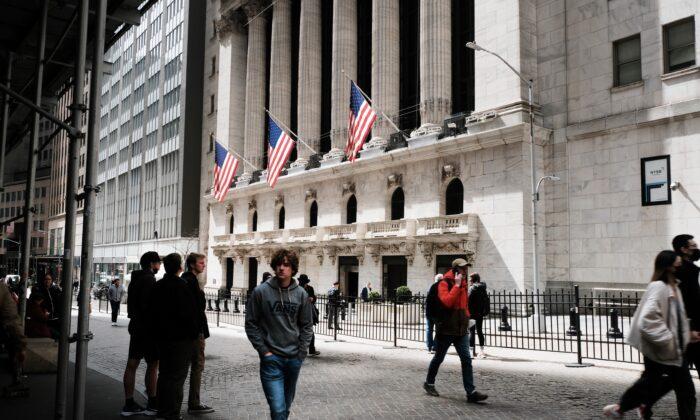Commentary
Phases of volatility across U.S. stocks have played out in the past two months.
After an initial war-driven decline in stocks ended in mid-March, replaced by a retail-driven melt-up, the U.S. stock market has been on unstable footing in April.
So where do investors go from here? While some experts—such as Goldman Sachs U.S. equity strategist David Kostin—are still bullish, investors would be wise to be extremely cautious going forward.
Most institutional investors don’t expect the market to rise in the near term, and that’s how retail investors should be positioned as well. Bank of America’s latest monthly global “fund manager survey” found most professional investors to be bearish.
More than 60 percent of the surveyed fund managers expect a bear market this year, with a likely decline of 20 percent of the major indices. Cash position—which signals how much money is on the sidelines uninvested—has increased to its highest levels since April 2020, the early days of the COVID-19 pandemic.
Professional fund managers surveyed by the bank are maintaining defensive positioning, with high allocations to commodities, cash, and consumer staples. And they are underweight allocations to war-sensitive sectors such as emerging markets and European stocks.
Morgan Stanley’s equity strategist Michael Wilson, one of the more accurate Wall Street market forecasters, also believes there are higher risks ahead. “The bear market rally is over,” Wilson declared in a recent note to clients, referring to the U.S. stock market rise in late March.
Summarizing various challenges that lie ahead, Wilson noted that “investors face multiple headwinds to growth that will be harder to ignore—payback in demand from last year’s fiscal stimulus, demand destruction from high prices, food and energy price spikes from the war that serve as a tax, and inventory builds that have now caught up to demand.”
Fed policy is unlikely to support risk assets going forward. The Federal Reserve’s current stance is a full-fledged endorsement of raising rates and fighting inflation. This is even championed by incoming Fed vice chair Lael Brainard—traditionally an extremely dovish Fed governor—who stated that the central bank needs to reduce its balance sheet “rapidly.”
Retail investors are wise to ditch the recent playbook of buying after each stock market dip. Looking ahead, the adage “sell in May and go away” could very well apply.
May also marks the beginning of the half-year mark ahead of mid-term elections, a historically terrible period for U.S. stocks.
Market performance has been even weaker during the first terms of Democratic presidents, according to the Stock Trader’s Almanac. Much of this pattern is due to monetary and fiscal policies, with typically tighter policies exhibited during the first two years of a presidency followed by various stimulus measures handed out in the second two years leading up to a new presidential election.
What about bonds, traditionally a safe haven when stock markets decline? Unfortunately, bonds don’t offer any reprieve, either—at the moment. The bond market’s wipeout over the last several weeks has been even worse than the stock market’s.
Much of that is because of the Fed. Quantitative tightening is about to begin, and at speeds previously unseen. The last phase of quantitative tightening occurred at a slow pace. How will the market react? We’re not sure, but investors shouldn’t sit around to find out.
The Fed balance sheet is at $9 trillion, roughly double its pre-pandemic size. It intends to run off its Treasuries portfolio at a pace of $60 billion per month. It won’t try to actively sell the bonds but intends to let maturing bonds run off, and they won’t be replaced. The Fed will likely have to actively sell its mortgage-backed securities (MBS) holdings as MBS maturities tend to lengthen as rates rise, due to consumers’ tendency to stop making prepayments from refinancing mortgages during periods of elevated interest rates.
In summary, there will be a lot of bonds in the market for investors to absorb, with prices likely to keep declining and yields rising.
This isn’t to say there aren’t any opportunities out there. Commodities and gold continue to attract inflows. Some experts also believe in selectively adding to beaten-down technology stocks, viewing it as a rare opportunity to own tomorrow’s “Apple and Amazon” at discount prices.
And cash—as higher rates begin to translate to higher deposit interest—isn’t the worst place to wait out a potential economic storm.






Friends Read Free